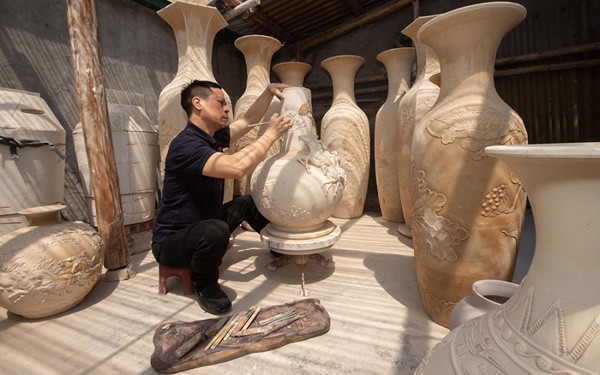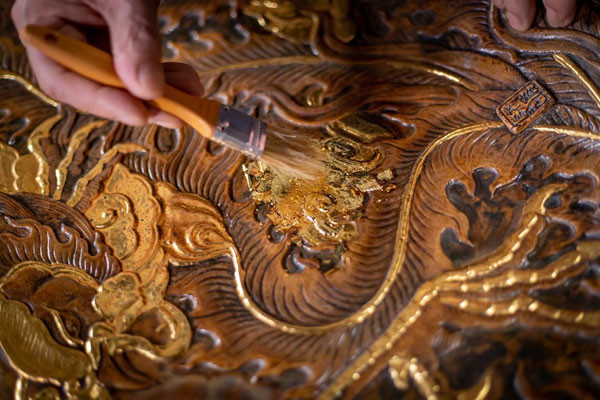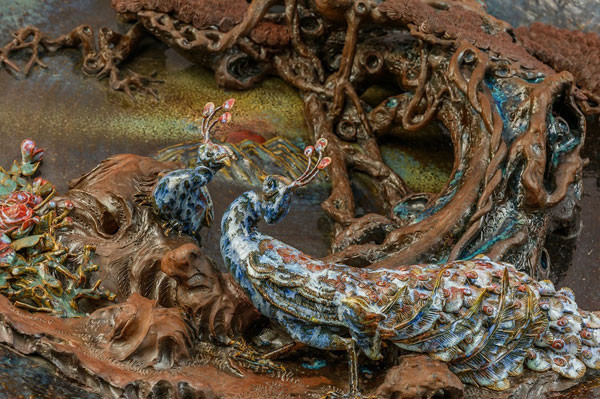Artisan Nguyen Hung from Bat Trang ceramic village in Hanoi is the creator of two artworks listed in Guinness World Records. He is also known for his many outstanding unique ceramic and enameling techniques.
Born to be a ceramic artisan

To the surprise of anyone who knows about his products, ceramist Nguyen Hung is not originally from Bat Trang. Born and raised in Hai Phong, he developed a love for pottery from an early age. In 1986, he joined Havinaco Company and had the opportunity to travel around Vietnam to learn about ceramics.
During those trips, not only did his love for pottery deepen, but he also had more opportunities that turned his life and career in a different direction. He decided to stay in Bat Trang Ceramics Village and pursue his passion, with a burning determination to build his pottery career.
In the early days without any technique, Nguyen Hung apprenticed at pottery workshops and broadened his knowledge, skills, and experience. Gradually, as his skills improved, he was accepted to larger, more reputable workshops, as well as recognized by his seniors in the village. He also built up his own ceramics business afterward.
One of the passions of the ceramist is learning about ancient glazes and creating new types based on them as he said that “I’m not from Bat Trang but passionate about pottery, and I want to explore and create new glazes from inheriting the ancient types invented by our predecessors”.
Bringing lotus into a new type of glaze

Bat Trang is an ancient pottery village, where potters compete fiercely on glazes and a lot of artisans have created unique and rare types. Enthusiastic about ash glaze, Nguyen Hung shared that ceramics is a harmonious blend of the five elements: Jin or metals - found in clay, Mu or wood - the rice husk biochar contained in the glaze, Shui or water - mixed with the clay, Huo of fire - for baking, and Tu or earth - the clay for molding.
Also, a lotus lover himself, the ceramist added: “Most of my products are associated with the images of lotuses, so I want to preserve something of the plant, I want it to be reincarnated in ceramics in my way.”
That was when he came up with the idea of burning the lotus stem - instead of the rice husk - to ashes to make a completely new glaze.
Having tirelessly tried many different methods for 15 years, artisan Nguyen Hung finally succeeded in replacing the Mu element in the traditional ash glaze. He mixed the lotus stalk ashes with the Red River sediments and ground powder of some natural minerals and introduced a new type of glaze named Hoang Tho Lien Hoa. ‘Hoang Tho’ -literally ‘yellow clay’- the alluvial deposits of the river, while ‘Lien Hoa’ means the lotus.

As explained by its father, this glaze is much different from the original. On one hand, it allows for a wider range of colors - from brown to reddish brown - compared to the plain ivory white of ash glaze. “This wider color range gives me more room for creativity, and is closer to painting on ceramics,” he stated.
On the other hand, it also enables a broader temperature range. In the past, ceramics were usually baked at only 1,100-1,200 degrees Celsius, beyond which the clay cores easily deform. Therefore, works using Hoang Tho Lien Hoa glaze have their special cores to withstand higher temperatures.
Another special feature of the glaze is that when fired at such temperatures, the glaze layer melts and blends with the core inside, producing the “Tu turning into Jin” effect. That’s why after being baked, the product is as solid as steel and sounds like a bell when being knocked. In short, the finished works have a better look and sound compared to the ones with traditional ash glaze.
After the first successful batch, Nguyen Hung continued his research to get more diverse colors on potteries, from which he could bring his creativity into full play. Some results of this process include the leopard skin, blue snow, or pink snow glazes, applied on his later products.
Overcoming his challenges

Another remarkable creation of artisan Nguyen Hung is a sculpting technique on ceramics with is far more difficult and requires sophisticated technical requirements. The main material of pottery is clay, which is not as hard as others and may easily crack or distort.
Moreover, the work must be put into kilns and withstand high firing temperatures while still maintaining the shape and decorative patterns. His sculpting style creates depth for ceramics and increases the uniqueness, but still retains the familiar looks of Vietnamese pottery with patterns depicting Dong Ho folklore, legends, or ancient stories in feng shui, as well as many works with lotus flowers.
At the Grand Plaza Hotel in Hanoi late last month, the titles of Guinness World Records were awarded to two ceramic artworks by artisan Nguyen Hung and the company he is working for Huong Viet Ceramics. Their names are “Thiem Thu Thien Phong An” or the Money Toad Seal of Heaven and the plate “Phu Quy Man Duong” or the House Full of Wealth and Nobility.
The newly recognized world-records

The ceramic artwork of “Thiem Thu Thien Phong An” weighs 1.5 tons and has a length of 1,735 meters, a width of 1.1 meters, and a height of 0.778 meters, depicting a three-legged toad sitting atop a pile of gold coins and bars, with a porcelain yin-yang symbol on its head, a gold coin in its mouth and the Great Bear constellation on its back.
This sculpture took the artisan six and a half months to complete, and set the record for “the Largest Ceramic Sculpture of a Mythical Creature.”
Meanwhile, the “Phu Quy Man Duong” ceramic plate weighs 400 kilograms and has a diameter of 1.37 meters, embossed and carved with a cedar tree and a pair of peacocks, along with such feng shui elements as a mountain and the sun to convey the meaning of eternal wealth, nobility, longevity, and happiness. The plate took about a year and a half to make, and established the record for “the Largest Carved Ceramic Plate”.
Nguyen Hung shared that, to make these two large-size works, the most difficult thing is to handle the tensile strength of the clay, because the clay itself is fragile, not to mention performing other handiworks. In the case of “Thiem Thu Thien Phong An”, he had to consider very carefully how to bring modern art patterns into the product, while still keeping the traditional features of Bat Trang pottery.

As for the plate “Phu Quy Man Duong”, this is the first time the ceramist has made a sculpture on such a large plate. Besides handling the tensile strength, he also had to use many interwoven technical factors to lay uneven clay on a flat plate. “I had to make many experiments and failed countless times to finally create these two products,” he said.
40 years in the craft, holding recognized and personal records, but for artisan Nguyen Hung, his greatest one is excelling beyond his creativity to continuously have new achievements.
“Failure is my teacher. If I don’t create my path and just follow the easy ones paved by others, I can’t become one of a kind. In that way, I would forever be the runner-up,” he shared.
Source: Hanoi Times